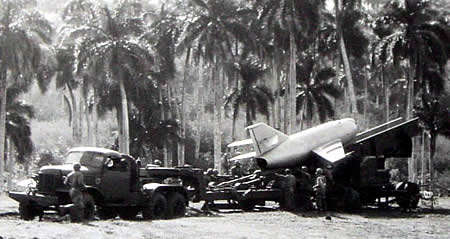Cuban Missile Crisis: Nuclear Order of Battle
 |
| At the time of the Cuban Missile Crisis blockade, unknown to the United States, the Soviet Union already had short-range nuclear weapons on the island, such as this FKR-1 cruise missile, that would most likely have been used against a U.S. invasion. |
.
By Hans M. Kristensen and Robert S. Norris
Fifty years ago the world held its breath for a few weeks as the United States and the Soviet Union teetered on the brink of nuclear war in response to the Soviet deployment of medium-range nuclear missiles in Cuba.
The United States imposed a military blockade around Cuba to keep more Soviet weapons out and prepared to invade the island if necessary. As nuclear-armed warships sparred to enforce and challenge the blockade, a few good men made momentous efforts and decisions that prevented use of nuclear weapons and eventually defused the crisis.
What the Kennedy administration did not know, however, was that the Soviet Union had 158 nuclear warheads of five types already in Cuba by the time of the blockade. This included nearly 100 warheads for short-range ballistic missiles and cruise missiles. If the invasion had been launched, as the military recommended but the White House fortunately decided against, it would most likely have triggered Soviet use of those short-range nuclear weapons against the U.S. Naval Base at Guantanamo and at amphibious forces storming the Cuban beaches. That, in turn, would have triggered wider use of nuclear forces.
In our latest Nuclear Notebook – The Cuban Missile Crisis: a nuclear order of battle, October and November 1962 – we outline the nuclear order of battle that the United States and the Soviet Union had at their disposal. At the peak of the crisis, the United States had some 3,500 nuclear weapons ready to use on command, while the Soviet Union had perhaps 300-500.
The Cuban Missile Crisis order of battle of useable weapons represented only a small portion of the total inventories of nuclear warheads the United States and Russia possessed at the time. Illustrating its enormous numerical nuclear superiority, the U.S. nuclear stockpile in 1962 included more than 25,500 warheads (mostly for battlefield weapons). The Soviet Union had about 3,350.
For all the lessons the Cuban Missile Crisis taught the world about nuclear dangers, it also left some enduring legacies and challenges that are still confronting the world today. Among other things, the crisis fueled a build-up of quick-reaction nuclear weapons that could more effectively hold a risk the other side’s nuclear forces in a wider range of different strike scenarios.
Today, 50 years later and more than 20 years after the Cold War ended, the United States and Russia still have more than 10,000 nuclear weapons combined. Of those, an estimated 1,800 nuclear warheads are on alert on top of long-range ballistic missiles, ready to be launched on short notice to inflict unimaginable devastation on each other. The best way to honor the Cuban Missile Crisis would be to finally end that legacy and take nuclear weapons off alert.
Nuclear Notebook: The Cuban Missile Crisis: A nuclear order of battle, October and November 1962
While it is reasonable for governments to keep the most sensitive aspects of nuclear policies secret, the rights of their citizens to have access to general knowledge about these issues is equally valid so they may know about the consequences to themselves and their country.
Nearly one year after the Pentagon certified the Sentinel intercontinental ballistic missile program to continue after it incurred critical cost and schedule overruns, the new nuclear missile could once again be in trouble.
“The era of reductions in the number of nuclear weapons in the world, which had lasted since the end of the cold war, is coming to an end”
Without information, without factual information, you can’t act. You can’t relate to the world you live in. And so it’s super important for us to be able to monitor what’s happening around the world, analyze the material, and translate it into something that different audiences can understand.